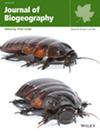We aim to investigate whether invasive alien plants introduced at different times exhibit variations in elevational distribution patterns and to explore the correlations of these patterns with climate, native plants and human activity.
Guangxi, China.
We recorded plant richness and cover across elevational gradients at 25–34 sites within each reserve, utilising 84–134 roadside plots per site. Using generalised linear mixed model (GLMM), we assessed the impacts of climate, native plants and human activity on the distributions of all, old and new invasive alien plants across the region and within the nature reserves.
At regional scales, the cover of all, new and old invasive alien plants decreased with increasing elevation, while only the richness of old invasive alien plants exhibited a similar pattern. Contrasting patterns were observed in Dayao Mountain, where the cover of old invasive alien plants decreased while the cover of new invasive alien plants increased. The richness patterns of all and new invasive alien plants were opposite between Dayao Mountain and Yachang Orchid. Moreover, native plant richness was negatively correlated with the richness of invasive alien plants, while interference intensity positively affected new invasive alien plants at both regional and reserve scales. At the regional scale, native plant richness accounted for 78.27%, 91.94% and 60.9% of all, old and new invasive alien plants respectively. Interference intensity accounted for 33.85% of the variation in new invasive alien plants. Annual mean temperature positively influenced the cover of all and old invasive alien plants at both regional and reserve scales, explaining 36.91% and 74.28% of their regional variation. Additionally, interference intensity and distance to human settlements positively impacted the cover of new invasive alien plants, contributing to 50.95% and 31.92% of their variation at regional scales.
The distinct distribution patterns of old and new invasive alien plants highlight the significance of residence time in understanding their dynamics. Climate factors constrain the cover distribution of all and old invasive alien plants, whereas interference intensity and distance to settlements determine the distribution of new invasive alien plants. Notably, native plants play a vital role in preventing the establishment and spread of invasive alien plants within nature reserves, and their effectiveness increases with longer residence times. Our findings highlight the critical importance of minimising human interference and conserving native species for the effective management of invasive alien plants in nature reserves.


